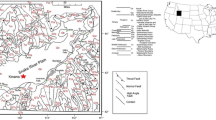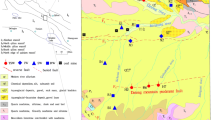Abstract
Geochemical data for thermal spring waters along the southern Rocky Mountain Trench in British Columbia, Canada were examined. The range of equilibration temperatures for the thermal springs is between 24 and 59°C, assuming that there is minimal mixing with colder shallow waters that might lead to a lowering of the calculated equilibration temperature. The chalcedony geothermometer is found to be the most appropriate given the carbonate host rocks. Temperature logs from 11 boreholes in the vicinity were used to calculate representative geothermal gradients, which range from 23.8 to 55.7°C/km with an average of 24.8±8.0°C/km. Using the average gradient and the range of equilibration temperatures calculated for each spring, the minimum range for the depth of origin of the thermal waters is 0.9–2.2 km. Heat flow values range from 90.3 to 155 mW/m2, with an average of 109.1±21.0 mW/m2. The moderate to high heat flow and heat generation result in generally higher temperatures at shallow depths, thus offering an explanation for the occurrence of thermal springs. The alignment of the thermal springs likely relates to the preferred northwest–southeast orientation for major thrust faults along the Rocky Mountain Trench, and with waters routed from depth along deep faults.
Résumé
Les données géothermiques de sources thermales le long de la partie sud du fossé des Montagnes Rocheuses en Colombie Britannique, Canada, sont étudiées. L’échelle des températures d’équilibre des sources thermales se situe entre 24 et 59°C, en assumant qu’il y a un mélange minimum avec les eaux froides de surface, ce qui conduit à une sous-évaluation de la température d’équilibre. La calcédoine apparaît être le géothermomètre le plus approprié vu les roches hôtes carbonatées. Les diagraphies de température provenant de 11 forages proches ont été utilisées pour calculer le gradient géothermique représentatif, gradient compris entre 23.8 et 55.7°/km avec une moyenne de 24.8°/km. En utilisant le gradient moyen et les valeurs de température d’équilibre calculées pour chaque source, la profondeur minimum des eaux thermales se situerait entre 0.9 et 2.2 km. Les flux de chaleur sont évalués entre 90.3 et 155 mW/m, avec une moyenne de 109.1±21.0 mW/m. Le transfert moyen de chaleur et la génération de chaleur résulte en températures ordinairement plus élevées aux faibles profondeurs, qui ainsi offre une explication à l’occurrence de sources thermales. Les alignements de sources thermales sont vraisemblablement en relation avec l’orientation Nord-Sud des principales failles-vraies le long du fossé des Montagnes Rocheuses, et avec l’écoulement des eaux des profondeurs le long des failles.
Resumen
Se examinan datos geoquímicos de aguas de fuentes termales a lo largo de la Trinchera sur de las Montañas Rocosas en Columbia Británica, Canadá. El rango de temperaturas de equilibrio para las fuentes termales se encuentra entre 24 y 59°C, asumiendo que existe mezcla mínima con aguas someras más frías que podrían conducir a un descenso de la temperatura de equilibrio calculada. El geotermómetro de calcedonia se ha encontrado que es el más apropiado debido a las rocas encajonantes carbonatadas. Se utilizaron los registros de temperatura de 11 pozos de la zona para calcular gradientes geotermales representativos, los cuales varían de 23.8 a 55.7°C/km con un promedio de 24.8±8.0°C/km. Utilizando el gradiente promedio y el rango de temperaturas de equilibrio calculadas para cada manantial, se estimó que el rango mínimo para la profundidad de origen de las aguas termales varía de 0.9 a 2.2 km. Los valores de flujo de calor varían de 90.3 a 155 mW/m2, con un promedio de 109.1±21.0 mW/m2. El flujo de calor moderado a alto y la generación de calor resultan en temperaturas generalmente más altas a profundidades someras ofreciendo de este modo una explicación para la ocurrencia de fuentes termales. El alineamiento de fuentes termales posiblemente se relaciona con la orientación preferida noroeste-sureste de fallas inversas principales a lo largo de la Trinchera de las Montañas Rocosas, y con aguas ascendentes profundas que se mueven a lo largo de fallas profundas.







Similar content being viewed by others
References
Armstrong RL (1988) Mesozoic and early Cenozoic magmatic evolution of the Canadian Cordillera. In: Processes in continental lithospheric deformation. Geol Soc Am Spec Pap 218:55–91
Back W (1966) Origin of hydrochemical facies in groundwater in the Atlantic Coastal Plain. In: Proceedings of International Geological Congress, Copenhagen, vol I, pp 87–95
Bally AW, Gordy PL, Stewart GA (1966) Structure, seismic data, and orogenic evolution of southern Rocky Mountains. Bull Can Petrol Geol 14:337–381
Banks D, Sletten RS, Haldorsen S, Dale B, Heim M, Swensen B (1998) The thermal springs of Bockjord, Svalbard: occurrence and major ion hydrochemistry. Geothermics 27(4):445–467
Chiba H, Sakai H (1985) Oxygen isotope exchange rate between dissolved sulphate and water at hydrothermal temperatures. Geochem Cosmochim Acta 49:993–1000
Clague JJ (1974) The St. Eugene Formation and the development of the southern Rocky Mountain Trench. Can J Earth Sci 11:916–938
Clark ID, Fritz P (1997) Environmental isotopes in hydrogeology. Lewis Publishers, New York
Coleman ML, Shepard TJ, Durham JJ, Rouse JD, Moore GR (1982) Reduction of water with zinc for hydrogen isotope analysis. Anal Chem 54:993–995
Coney PJ, Jones DL, Monger JWH (1980) Cordilleran suspect terranes. Nature 288:329–333
Craig H (1961) Isotopic variations in meteoric waters. Science 133:1702–1703
Epstein S, Mayeda TK (1953) Variation of18O content of waters from natural sources. Geochim Cosmochim Acta 4:213–224
Foo WK (1979) Evolution of transverse structures linking the Purcell Anticlinorium to the western Rocky Mountains near Canal Flats, British Columbia. MSc, Queen’s, Kingston, Ontario, Canada
Forster C, Smith L (1988a) Groundwater flow systems in mountainous terrain 1. Numerical modeling technique. Water Resour Res 24:999–1010
Forster C, Smith L (1988b) Groundwater flow systems in mountainous terrain 2. Controlling factors. Water Resour Res 24:1011–1023
Fournier RO (1973) Silica in thermal waters: laboratory and field investigations. In: Proceedings of International Symposium on Hydrogeochemistry and Biogeochemistry, Tokyo, pp 132–139
Fournier RO (1977) Chemical geothermometers and mixing models for geothermal systems. Geothermics 5:41–50
Fournier RO (1979) A revised equation for the Na/K geothermometer. Geotherm Resour Counc Trans 5:1–16
Fournier RO (1981) Application of water geochemistry to geothermal exploration and reservoir engineering, chap 4. In: Rybach L, Muffler LJP (eds) Geothermal systems: principles and case histories. Wiley, New York, pp 109–143
Fournier RO, Truesdell AH (1973) An empirical Na–K–Ca geothermometer for natural waters. Geochim Cosmochim Acta 37:1255–1275
Gabrielse H (1985) Major dextral transcurrent displacements along the northern Rocky Mountain trench and related lineaments in north-central British Columbia. Geol Soc Am Bull 96:1–14
Gabrielse H, Yorath CJ (1989) DNAG No. 4. The Cordilleran Orogen in Canada. Geosci Can 16:67–83
Ghomshei MM, Clark ID (1993) Oxygen and hydrogen isotopes in deep thermal waters from the South Meager Creek geothermal area, British Columbia, Canada. Geothermics 22(2):79–89
Grasby SE, Hutcheon I (2001) Controls on the distribution of thermal springs in the southern Canadian Cordillera. Can J Earth Sci 38(3):427–440
Grasby SE, Hutcheon I, Krouse HR (2000) The influence of water–rock interaction on the chemistry of thermal springs in western Canada. Appl Geochem 15:439–454
Hitchon B (1984) Geothermal gradients, hydrodynamics, and hydrocarbon resources, Alberta, Canada. Am Assoc Petrol Geol J 68:713–743
Hyndman RD, Yorath CJ, Clowes RM, Davis EE (1990) The northern Cascadia subduction zone at Vancouver Island: seismic structure and tectonic history. Can J Earth Sci 27:313–329
Jessop AM, Lewis TJ, Judge AS, Taylor AE, Drury MJ (1984) Terrestrial heat flow in Canada. Tectonophysics 103:239–261
Kharaka YK, Mariner RH (1988) Chemical Geothermometers and their application to formation waters from sedimentary basins. In: Thermal history of sedimentary basins; methods and case histories. Springer, Berlin Heidelberg New York, pp 99–8117
Krouse HR (1980) Sulphur isotopes in our environment. In: Fritz P, Fontes JC (eds.), Handbook of Environmental Isotope Geochemistry, Vol. 1., The Terrestrial Environment. Elsevier, Amsterdam, pp. 435–471
Leech GB (1954) Canal Flats, British Columbia. Geological Survey of Canada, Canada
Lewis TJ, Souther JG (1978) Meager Mountain, B.C.—a possible geothermal energy resource. Earth Physics Branch, Energy Mines and Resources Canada
Lewis TJ (1991) Heat flux in the Canadian Cordillera. In: The Neotectonics of North America. Decade of North American Geology. Geol Soc Am, pp 445–456
Lewis TJ, Benthowski WH, Hyndman RD (1992) Crustal temperatures near the Lithoprobe Southern Canadian Transect. Can J Earth Sci 29:1197–1214
Lopez DL, Smith L (1995) Fluid flow in fault zones; analysis of the interplay of convective circulation and topographically driven groundwater flow. Water Resour J 187:71–87
Lopez DL, Smith L (1996) Fluid flow in fault zones; influence of hydraulic anisotropy and heterogeneity on the fluid flow and heat transfer regime. Water Resour Res 32(10):3227–3235
Mizutani Y, Rafter TA (1969) Oxygen isotopic composition of sulphates, 3. Oxygen isotopic fractionation in the bisulfate ion-water system. New Zealand J Sci 12:54–59
Monger JWH, Price RA, Templeman-Kluit DJ (1982) Tectonic accretion and the origin of the two major metamorphic and plutonic belts in the Canadian Cordillera. Geology 10:70–75
Parrish RR, Carr SD, Parkinson DL (1988) Eocene extensional tectonics and geochronology of the southern Omenica Belt, British Columbia and Washington. Tectonics 7:181–212
Price RA (1962) Fernie map-area, east half, Alberta and British Columbia. Geological Survey of Canada, Canada
Price RA, Carmichael DM (1986) Geometric test for Late Cretaceous-Paleogene intracontinental transform faulting in the Canadian Cordillera. Geology 14(6):468–471
Satterley J, Elworthy RT (1917) Mineral springs of Canada, Part I—The radioactivity of some Canadian mineral springs. Can Mines Branch Bull 16:60
Shakur A (1982) 34S and18O variations in terrestrial sulphates. PhD thesis, University of Calgary, Alberta, Canada
Souther JG (1976) Geothermal potential of western Canada. In: Proceedings of 2nd United Nations Symposium on the Development and Use of Geothermal Resources, San Francisco, CA, vol 1, pp 259–267
Souther JG, Halstead EC (1973) Mineral and thermal waters of Canada. Department of Energy, Mines and Resources Canada
Souther JG, Dellechaie F (1984) Geothermal exploration at Mt. Cayley—a quaternary volcano in southwestern British Columbia. Geotherm Resour Counc Trans 6:463–468
Stiff HJ Jr (1951) The interpretation of chemical water analysis by means of patterns. J Petrol Technol 3:15–17
Truesdell AH, Hulston JR (1980) Isotopic evidence of environments of geothermal systems. In: Fritz P, Fontes JC (eds) Handbook of environmental isotope chemistry, vol. 1. Elsevier, New York, pp 179–226
van der Velden AJ (1995) Subsurface geometry and tectonic controls on the development of the Rocky Mountain trench in southeastern British Columbia, Canada. Unpublished MSc, University of Calgary, Calgary Alberta, 91 pp
van der Velden AJ, Cook FA (1994) Displacement of the Lewis thrust sheet in the southwestern Cordillera: new evidence from seismic reflection data. Geology 22:819–822
van Everdingen RO (1969) Degree of saturation with respect to CaCO3, CaMg(CO3)2, and CaSO4 for some thermal and mineral springs in the Southern Rocky Mountains, Alberta and British Columbia. Can J Earth Sci 6:1421–1430
van Everdingen RO (1972) Thermal and mineral springs in the southern Rocky Mountains of Canada. Water Management Service Department of the Environment, Ottawa, Ontario, Canada
Wiwchar B, Perkins EH, Gunter WD (1988) SOLMINEQ.88 PC/SHELL manual. Alberta Research Council, Oil Sands and Hydrocarbon Recovery Department
Woodsworth G (1999) Hot springs of western Canada: a complete guide. 2nd edn. Gordon Soules Publishers, West Vancouver, 288 pp
Yanagisawa F, Sakei H (1983) Precipitation of SO2 for sulphur isotopic ratio measurements by thermal decomposition of BaSO4–V2O5–SiO2 mixtures. Anal Chem 55:985–987
Yorath CJ, Gordy PL, Williams GK, Bustin RM, Bell RT, Souther JG, Halstead EC (1991) Energy and ground water resources of the Canadian Cordillera, chap 20. In: Gabrielse H, Yorath CJ (eds) Geology of the Cordilleran Orogeny in Canada, vol 4. Geol Surv Can, Geology of Canada, pp 769–801
Acknowledgements
The authors would like to acknowledge the scientific contributions of Robert van Everdingen. We would also like to acknowledge the members of the Geothermal Group within the former Earth Physics Branch of Energy, Mines and Resources, Canada for their contributions to the Canadian geothermal database.
Author information
Authors and Affiliations
Corresponding author
Rights and permissions
About this article
Cite this article
Allen, D.M., Grasby, S.E. & Voormeij, D.A. Determining the circulation depth of thermal springs in the southern Rocky Mountain Trench, south-eastern British Columbia, Canada using geothermometry and borehole temperature logs. Hydrogeol J 14, 159–172 (2006). https://doi.org/10.1007/s10040-004-0428-z
Received:
Accepted:
Published:
Issue Date:
DOI: https://doi.org/10.1007/s10040-004-0428-z




